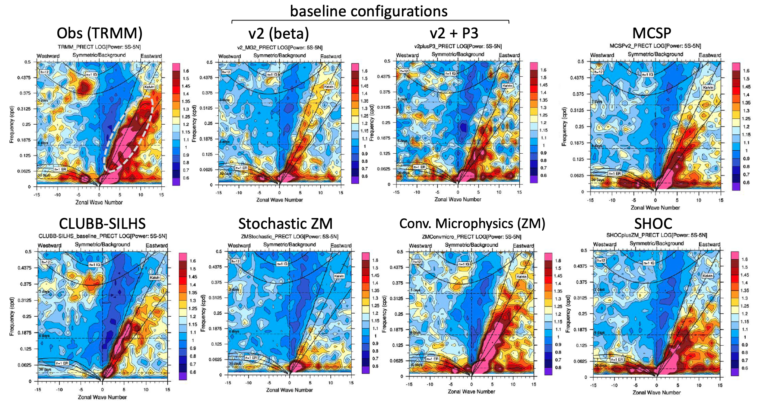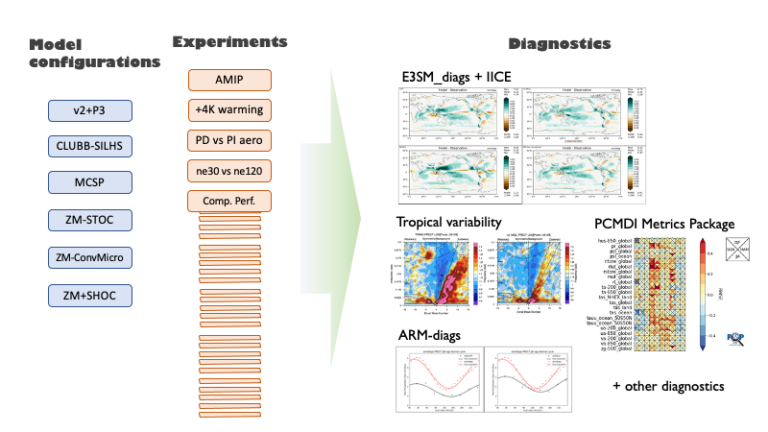Convection Assessment for E3SM
Comparing and assessing convection schemes for the E3SM Atmosphere Model v3
Improving convection in E3SM Atmosphere Model v3 (EAMv3)
Even as the E3SM v2.0 model was being finalized for release, work continued under the NGD Atmospheric Physics project to improve the physics for the next generation of the E3SM Atmosphere Model (EAM). With the aim to include convection physics previously unresolved and to improve persistent climate biases in E3SM, teams developed or ported new convection schemes and enhancements, including 1) CLUBB-SILHS to unify shallow and deep convection (Larson et al., 2017), 2) SHOC, a simplified turbulence and shallow convection scheme to replace CLUBB (Bogenschtuz and Krueger, 2013), 3) the Multiscale Coherent Structure Parameterization (MCSP) to include the impacts of meso-scale convection (Moncrieff et al., 2017), 4) a stochastic convection scheme for the ZM deep convection scheme (Wang et al., 2021), and 5) a more sophisticated convective cloud microphysics scheme for the ZM scheme (Song et al., 2012). The multi-plume Eddy-Diffusivity/Mass-Flux (EDMF) approach (Suselj et al., 2019), which presents a unified scheme for turbulence, shallow convection, and deep convection, shifted their focus from implementing the scheme for the v3 model to have it work with the SCREAM model.
Multi-simulation/multi-diagnostic evaluation for the EAMv3 convection assessment
The EAMv3 convection assessment activity was an opportunity to evaluate the new developments. Five different convection configurations (Fig. 1) were tested and evaluated against the baseline model configuration, which combined the E3SM v2 model with P3 microphysics (Wang et al., 2021). A total of 400 years of simulation were run across the teams to cover five different experiments. These experiments were designed to examine the present-day climatology and variability, the sensitivity to model resolution, the response of the model to warming and aerosol perturbations, and the impact on computational performance.
The evaluation of the simulation output benefited from a wide variety of diagnostic tools and expertise from E3SM (E3SM-diags, Interface for Inter-Comparison of E3SM_diags, e3sm_to_cmip) and contributions from collaborators, including Tropical variability diagnostics (NCAR), PCMDI Metrics (PMP team), ARM-diagnostics (ARM), and cloud feedbacks diagnostics (PCMDI). The assessment revealed how difficult it is to significantly improve on the recently released v2 model, but some climate features are improved with the new schemes.
When running with P3 microphysics, the mean-state precipitation and cloud patterns are less sensitive to changes in horizontal resolution (1 to 1/4 degree). The stochastic ZM scheme reduces the frequency of light rain and increases the frequency of extreme precipitation rates (biases that exist in most climate models), whereas the MCSP scheme strengthens and improves tropical waves. CLUBB-SILHS and SHOC respectively improve the double ITCZ and stratocumulus cloud cover but are not ready to replace the current convection pair of CLUBB-ZM for EAMv3. The most notable improvements were found with a more sophisticated convective microphysics in ZM, with moderate improvements in the mean-state precipitation and radiation fields and the diurnal cycle of precipitation, and dramatic improvement in the tropical variability (Kelvin waves and MJO) (Fig. 2), while also not adding to the computational cost.

Figure 2. Diagnostic capturing the modes of Tropical variability found in obs (TRMM- top left) and different model configurations. What is shown is the wave number frequency spectra of daily precipitation rate (Wheeler and Kiladis, 1999). Certain schemes, particularly the convective microphysics, leads to improved representation of Tropical Kelvin waves (circled in gray in the TRMM plot). Diagnostic courtesy of Jack Chen (NCAR).
What’s next
Next, the convective microphysics scheme and other schemes with potential for improvement (MCSP and stochastic ZM) will be integrated with the current convection pair in EAMv2 (CLUBB-ZM) to produce a candidate v3 convection configuration before the integration of other physics and chemistry components. An article summarizing the findings is also being prepared for publication.
Acknowledgement
This work was primarily funded by the DOE E3SM-NGD Atmospheric Physics Project. The MCSP and the ZM enhancements with the stochastic scheme and convective cloud microphysics were also supported by the DOE ESMD program to NCAR and UCSD, respectively. Specific thanks to the NGD-atmosphere convection parameterizations development teams and the P3 team as well as the convection assessment advisory committee. Input and help were received from the NGD-Atmospheric Physics team, the E3SM Infrastructure team, the E3SM-Diags team, the PCMDI PMP team, the ARM-Diags team, and E3SM science groups.
Contact
- Shaocheng Xie, Lawrence Livermore National Laboratory
- Chris Terai, Lawrence Livermore National Laboratory
This article is a part of the E3SM “Floating Points” Newsletter, to read the full Newsletter check:



